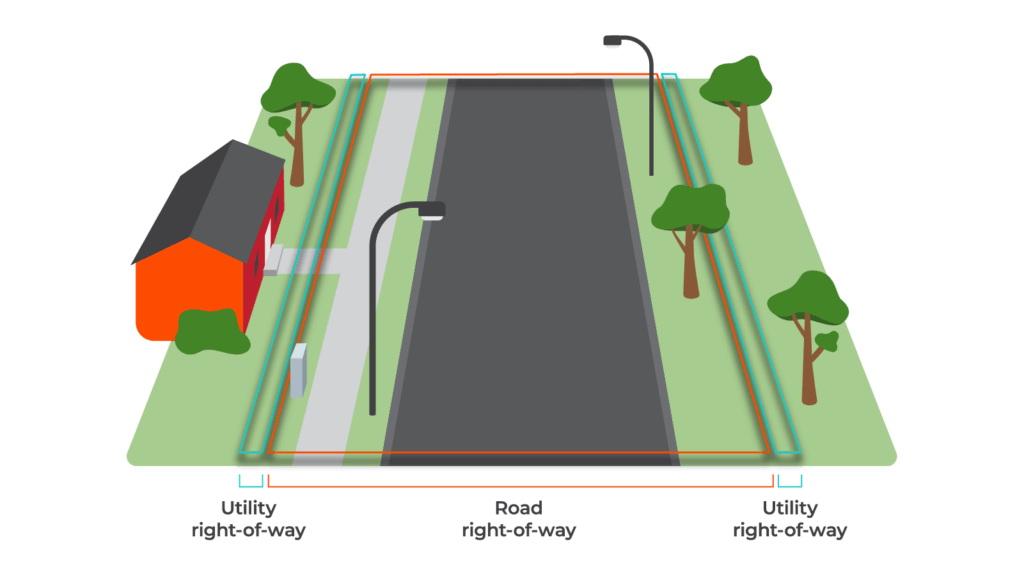As construction for the Valley Line West LRT progresses, Edmontonians may have noticed the intricate web of utility infrastructure being reconfigured above and below ground throughout the city. These essential components, including gas lines, sewer systems, communication cables, and more, are hidden beneath our feet or tucked away along the city’s rights-of-way.
Why Rights-of-Way are Necessary
The City of Edmonton manages access to all municipal rights-of-ways, which are crucial for various utility-related projects. Before any work can commence, whether it involves above-ground or below-ground activities, a permit to access the right-of-way is essential. The Valley Line West LRT Project Agreement with the City of Edmonton provides more information on the permit allowing Marigold to work within the City’s right-of-way.
Most properties have two types of rights-of-way: the road right-of-way and the utility right-of-way.

Road Right-of-Way
The road right-of-way refers to public property designated for traffic and pedestrian use. This space is where the city installs vital amenities like light poles, trees, and sidewalks. The width of the road right-of-way can vary from one community to another. This area ensures safe and efficient transportation and accommodates utility infrastructure that serves the neighborhood.
Additionally, it is worth noting that road rights-of-way can also be temporarily utilized for various purposes, such as election signs, planters, wayfinding signage, and more. However, a license is required for such temporary use. Contact the City of Edmonton via 311 for more information.
Utility Right-of-Way
Unlike the road right-of-way, which is public property, the utility right-of-way is an easement granted by property owners to the City of Edmonton. This easement from the property owner grants permission to the City to allow utility infrastructure to be installed both above and below the ground. It is important to understand that not all properties have a utility right-of-way. The location of the utility right-of-way can vary, often beginning at your property line and extending toward your home. Depending on your property, it may also be situated on the side or even at the back of your house. Property owners can refer to the Certificate of Title for the property to identify easements and rights-of-ways.
The utility right-of-way plays a pivotal role in ensuring that essential services, such as gas, water, sewer, and communication lines, can reach your property efficiently. Interfering with these utilities has serious consequences. Before digging in your yard, homeowners should always “click before you dig” to ensure they know where the utility lines are located.
Colour Coded Site Markings
When it comes to utility location, Marigold employs a simple yet effective system of colored flags and markers to indicate the presence of active lines running below ground. These color codes help crews dig in the right locations to access only the type of utility line being worked on. Here is a quick guide to what each flag color represents on the project:

- Pink: Indicates the City of Edmonton’s property line, within which construction work can take place
- Blue: Water lines
- Green: storm and sanitary sewer lines
- Red: cables
- Orange: communication lines or the back edge of the walkway.
- Yellow: gas lines.
The majority of Marigold’s work takes place on City property, marked by the pink flags. However, in many scenarios, crews may need room outside of this limit to complete their work. When this happens, Marigold is committed to remediate and return the excess area back to its original condition once construction is complete.
Understanding these color codes can be immensely helpful in ensuring the safety of construction workers and property owners in preventing accidents related to utility lines. Tampering with the underground utilities can directly impact your property resulting in serious injuries, financial losses, and service interruptions. All of these are easily avoidable by getting your underground utilities marked.
Edmonton’s extensive network of utility infrastructure is essential for maintaining the City’s functionality and ensuring that residents have access to vital services. By understanding the concept of rights-of-way and the significance of both road and utility rights-of-way, residents can better navigate and appreciate the complex web of infrastructure that supports their daily lives. Additionally, being aware of the color-coded site markings provides a layer of safety and awareness during construction projects, ultimately contributing to a more informed and secure community.